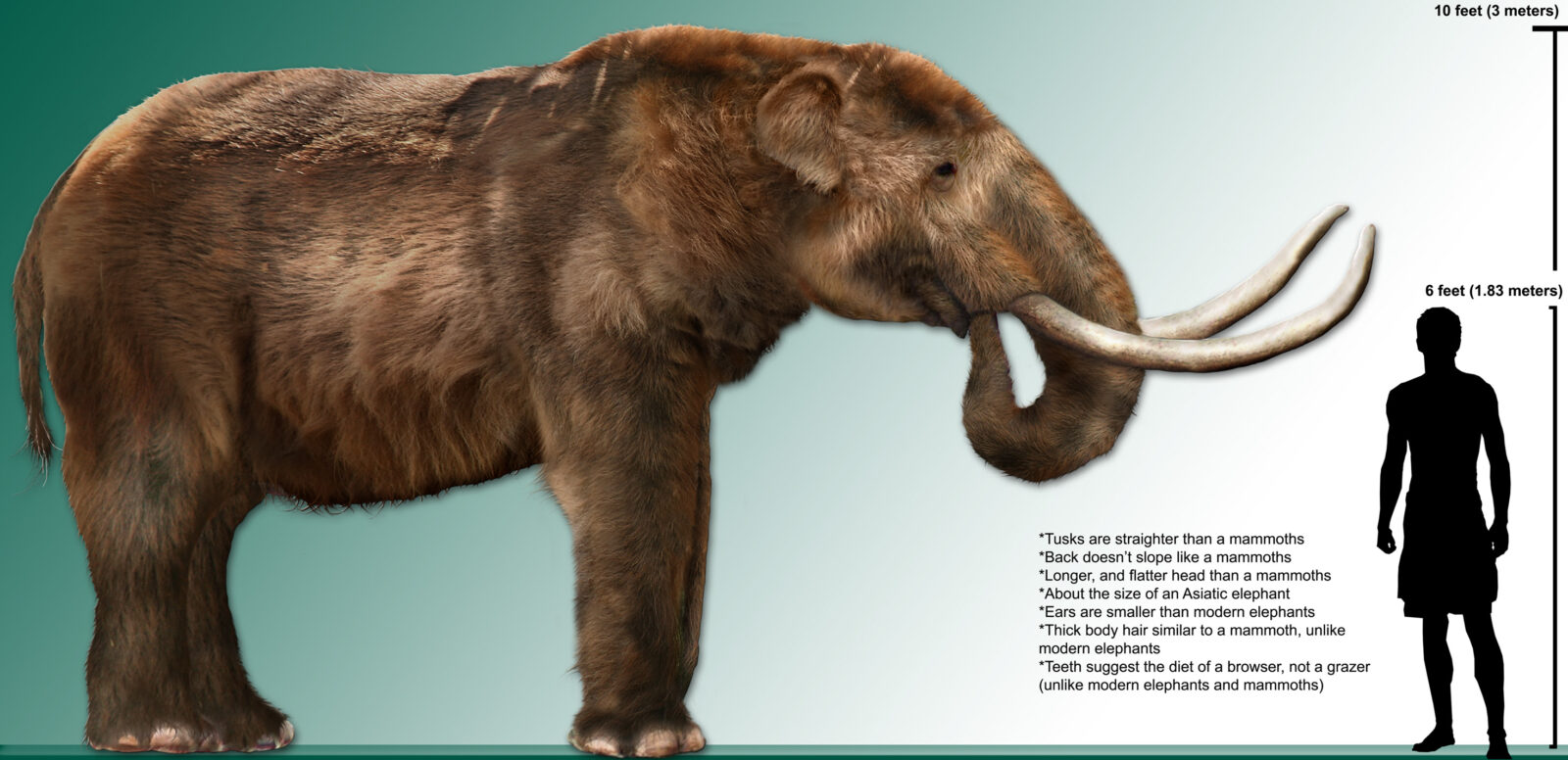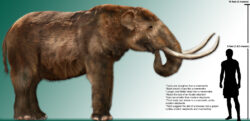Pre-Clovis and Clovis Cultures
This entry covers the Pre-Clovis and Clovis cultures during the Early Paleoindian Period, 11500–9500 BCE, and Middle Paleoindian Period, 9500 BCE–8800 BCE.

Dantheman9758, Wikimedia Commons, CC 3.0
Paleoindians shared the land with megafauna, including mastodons.
The Paleoindian (meaning “Old Indian”) period contains three cultures: pre-Clovis, Clovis, and, transitioning from the end of the Clovis culture to the Early Archaic period, San Patrice. No Pre-Clovis culture sites have been found in Louisiana, so the Clovis culture, with its iconic spear point, is the earliest culture that can be discussed with local evidence. A few Clovis sites are known in Louisiana, but most Clovis culture artifacts are found because they eroded out of riverbanks or were brought up by construction. Information from other states is filling in our understanding of this culture.
Paleoindians inhabited the United States at the end of the geological Pleistocene epoch (11500 BCE)—that is, near the end of the most recent Ice Age. Because the earth was considerably colder, a tremendous amount of the earth’s water was captured as glacial ice, and sea level was as much as four hundred feet lower than today. The Louisiana coast was up to seventy miles further south than it is today. Instead of the meandering river we see today, the Lower Mississippi River Valley carried a fast-moving, braided stream. Paleoindians shared their territory with mastodons, mammoths, giant sloths, and little horses, among other Pleistocene megafauna. In many other states, spear points have been found embedded in the mineralized bones of some of these animals, although there are no confirmed instances of this in Louisiana.
Pre-Clovis Culture
The idea of a Pre-Clovis culture in the Western Hemisphere has been quite controversial. However, there are now many carefully excavated Paleoindian sites that contain discrete stone tool assemblages below Clovis culture deposits; many, if not most, archaeologists accept the reality of humans in the New World prior to 9500 BCE. Pre-Clovis sites are found from Pennsylvania to southern Chile, but none has been found in Louisiana. Inundation by rising sea levels, burial by river sediments, and erosion of older landforms make Louisiana a particularly challenging place to look for such old sites.
Clovis Culture: Definition and Important Sites
The Clovis culture, along with the Clovis spear point, was named after the town of Clovis in New Mexico, where some of the first Clovis points were found. However, Clovis points are distributed throughout the United States, and they are surprisingly similar over this huge range.
The same factors affecting the preservation of pre-Clovis sites are present for Clovis culture sites. Indeed, the vast majority of Clovis points found in the state are “isolated finds”; that is, they are points that are not associated with any other stone artifacts or cultural features like hearths or pits.
Clovis culture archaeological deposits are known from only a very few sites in Louisiana, and even the most famous of these has interpretive issues. The John Pearce site, in Caddo Parish, is a case in point. While many of the stone tools from the site were attributed to the subsequent Late Paleoindian/Early Archaic San Patrice culture, three Paleoindian points were recovered. Two of these came from a possible pit. One was a classic, but very small, fluted Clovis point, and the other was of an average size, but not as finely worked as most Clovis points. However, the excavators were unsure whether the pit feature was a cultural feature or whether the soil discoloration tentatively identified as a pit was due to modern logging. Three other possible Paleoindian points were found at the site, but the excavators were careful not to call them Clovis.
The same uncertainty of taxonomy exists for the stone tool assemblage from the Eagle Hill II site, on Peason Ridge in Sabine Parish. The site is considered to be Folsom culture (coeval with San Patrice) by its excavators, but some experts regard a few of the projectile points from the site as earlier Clovis points. Whether or not Clovis points were present at the Eagle Hill II site, Clovis points have been recovered from Peason Ridge. The Eagle Hill area attracted Paleoindian people not only because of its favorable setting in terms of food resources, but also because the area contains Eagle Hill chert, a silicified (fossilized) wood that is a reasonably good raw material for stone tools. About 95 percent of the tools at the Eagle Hill II site were made of this stone. In addition to points, the Eagle Hill II site had other typical Paleoindian tools, including scrapers, various styles of burins (worked flakes with a pronounced point, used to engrave bone and antler), and retouched flakes made of this local material.
Clovis Culture Artifacts
Despite their great age, Clovis points are some of the finest points ever made in the United States. Clovis points, like most other points, were made by knapping, or striking a chert or flint nodule with a harder stone until the basic shape was achieved. Then the “blank” had to be thinned and sharpened. Clovis knappers used one or two distinctive techniques that allowed for thinning over a relatively large, horizontal area with a minimum of strokes. Finer details were created by pressure flaking—literally pushing bits of stone off the tool with a deer antler. Perhaps the most technically difficult step in the production of the point is the last step—the creation of a distinctive “flute” or groove on one or both sides of the point—which may have aided in attaching the point to a spear. These techniques required a homogeneous, fine-grained stone. Except for in the Eagle Hill area, Clovis points in Louisiana are almost always made of stone from other states, because what little stone is accessible locally is not large enough or fine-grained enough to create a Clovis point. Clovis points vary quite a bit in size, from one and a half to six inches, with an average length of between three and four inches.
Clovis and other contemporaneous points are generally considered to be spear points. On the basis of techniques used to hunt elephants in Africa and elsewhere, researchers suggested that Clovis points were hafted (tied) to a long, heavy shaft that was thrust, more than thrown, at Pleistocene megafauna. However, more recent studies of microscopic wear patterns indicate that the point may have been a more generalized tool—what one archaeologist called the “Leatherman of the Clovis toolkit.” The blade may have been hafted on a spear for the occasional mammoth hunt, but it was also used as a knife and a scraper.
As noted above, throughout their range, Clovis points are typically associated with a set of other stone tools including scrapers, burins, and other tools, many of which correspond with woodworking.
Daily Lives and Deaths
Until quite recently, scholars thought the Clovis culture embodied the idea of “man the hunter.” In this view, small bands of people were highly mobile and specialized in hunting mammoths or mastodons, and, to a lesser extent, other Pleistocene animals. The widespread distribution of Clovis points was seen as a natural result of bands of Clovis hunters following along as the herds of animals roamed over huge territories. It followed from this preconception that the Clovis culture diet was based primarily on the meat provided by the huge beasts. Examination of food remains in the few sites with good preservation now indicates a much more diverse diet. For instance, at the Gault site in Texas, frog, bird, and small mammal bones are present along with those from big game; turtles are the most common animal found on Clovis sites in North America. Archaeologists know little about Clovis culture use of plants, but the emerging information on hunting suggests that plants may have played a major role in the diet as well.
No Clovis culture burials have been found in Louisiana, so nothing is known about their mortuary activities.
The Clovis culture disappeared around 8800 BCE. Archaeologists have blamed climate change (it became colder), the extinction of the Pleistocene large game animals (through climate change and overhunting), and even comet strikes (producing the climate change) to explain the demise, but there is little agreement. In Louisiana, there is scant evidence for significant climate change, but cultural changes are consistent with those elsewhere.
Final Thoughts
Instead of relying on chance encounters with isolated Clovis points, archaeologists are now examining the geology of the Pleistocene-to-modern landscape in order to pinpoint areas where Clovis and pre-Clovis sites are more likely to have been preserved. As more information becomes available, the understanding of Clovis culture is likely to continue to change at a rapid rate.
